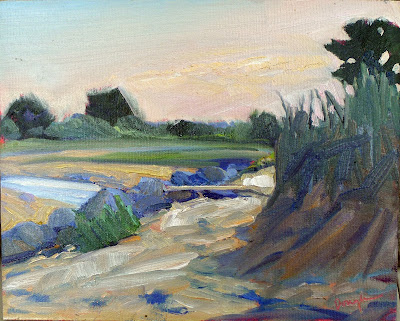I was momentarily surprised, because I’m subsumed into the cult of the picture plane and my correspondent isn’t (yet).
 |
| The Alaska Range, 12X16, oil on canvasboard, $1159 unframed |
In 1960, art critic Clement Greenberg coined a phrase, “the integrity of the picture plane.” What he meant by picture plane is the slice of space in which the image hangs. There’s three-dimensional reality behind it and in front of it, but for our purposes, all that exists is what’s on that screen.
Since then, an enormous amount has been written supporting or refuting Greenberg’s thesis (which is interesting, wordy and doesn’t concern us here). His critics countered that the artist can do whatever the #$% he wants with the picture plane. (Hey, it was the Sixties.)
But for practical painting purposes, that rectangle of space remains paramount. It has its own life, separate from the things that are depicted on it. It has primacy. That’s why we design paintings to look good in that rectangle, after all.
| Blueberry Barrens, oil on canvas, 24X36, $3188 unframed. |
I was recently asked, “which do you paint first, the foreground or background?” The question momentarily surprised me. That’s because I’m subsumed into the cult of the picture plane and my interlocutor isn’t (yet).
The answer is: “Neither. Both.”
The primacy of the picture frame overrides the relationships between foreground and background. In modern alla prima painting, objects and non-objects alike are tesserae placed in a mosaic. Background and foreground are developed together because they’re equal parts of the same visual illusion.
 |
| Downdraft snow, oil on canvasboard, 9X12, $696 unframed. |
That doesn’t mean there isn’t an order of operation to oil painting:
- Dark to light (to prevent hopeless muddying of color);
- Big shapes to small shapes;
- Fat over lean (the amount of solvent/oil you’re using in each layer);
Just as there is a general order of operations of watercolor painting:
- Underwash;
- Broad washes;
- Detail
| Parrsboro at Dawn, oil on canvasboard, $869 unframed. |
Nowhere does the relative importance of one object in the painting take precedence over another. We dart around the painting and finish it to one level, then to the next, then to the next. We think about passages of light and dark and how they interact to drive the eye. The subconscious mind will generally take care of the detail anyway, returning to those passages and poking at them until they’ve achieved some level of finish.


